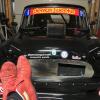Years back when I was getting this and doing much as you had done, except fitting them dry, rather that something as heavy as CV grease, I tried 3-in-1 Oil, with the idea that under the high pressure the Oil Film would break down. I first did this with an all steel flywheel that was proving to be troublesome in the same way as what you've found and haven't looked back. The amount of Oil I use here is just a lightest of licks. I'll add that I really do heave down hard on the flywheel bolt, I've not ever measured just how tight I've done the bolt up, but at a guesstimate, it would be a minimum of 200 ft/lb. In order to stop any fretting, the joint between the crank and the flywheel has to be very tight. It's not an ideal arrangement. I have a 12 tonne flywheel puller and these steel flywheel need just about every ounce of those 12 tonnes to get these flywheels off, however, when they come off, the tapers are totally clean.
Be warned though, that with the flywheel going on this way, it will seat deeper and so you need to check the primary gear isn't going to get pinched, which you should check as a matter of course in any case.
I have been fitting all flywheels, including the all steel types this way for around 25 years now and never had an issue.
The other thing here you may wish to try is going to a cast iron hub rather than a steel one, which is too close in material type & composition to being the same as the crank, being so similar encourages them to 'weld' when fretting. Going to a Cast Iron Hub won't stop the fretting, if it's going to occur, but they won't weld.
It may also be worth checking the taper in your hubs isn't getting a step in them as they are longer than the taper on the crank, If there is a step forming here, it will in a huge way stop the flywheel from seating down. As a matter of routine I actually turn the small part of that taper in the flywheel parallel for the last (roughly) 2 mm so that a step can't form in the first place.















